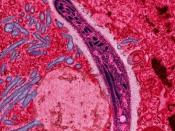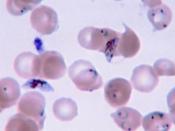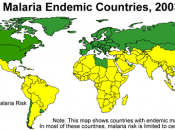Great Paper Great Paper
Malaria
Malaria parasites have been with us since the beginning of time, and fossils of mosquitoes up to thirty million years old show that malaria's vector has existed for just as long. The parasites causing malaria are highly specific, with man as the only host and mosquitoes as the only vector. Every year, 300,000,000 people are affected by malaria, and while less than one percent of these people die, there are still an estimated 1,500,000 deaths per year. While Malaria was one of the first infectious diseases to be treated successfully with a drug, scientist are still looking for a cure or at least a vaccination today (Cann, 1996). Though many people are aware that malaria is a disease, they are unaware that it is life threatening, kills over a million people each year, and is a very elusive target for antimalarial drugs (Treatment of Malaria, 1996).
Being a very specific disease, malaria is caused by only four protozoal parasites: Plasmodium falciparum, Plasmodium vivax, Plasmodium ovale, and Plasmodium malariae. Not only is the disease specific, but the parasites are too, with only 60 of 380 species of female Anopheles mosquitoes as vectors. With the exception of Plasmodia Malariae which may affect other primates, all parasites of malaria have only one host, Homo sapiens. Because some mosquitoes contain substances toxic to Plasmodium in their cells, not all species of mosquitoes are vectors of Plasmodium. Although very specific, malaria still causes disruption of over three hundred million people worldwide each year (Cann, 1996).
The life cycle of the parasite causing malaria exists between two organisms, humans and the Anopheles mosquito. When a female mosquito bites a human, she injects an anticoagulant saliva which keeps the human bleeding and ensures an even flowing meal for her. When...


